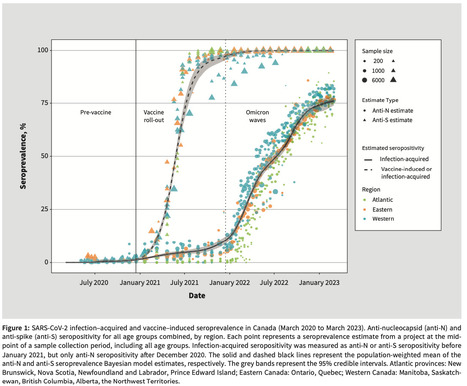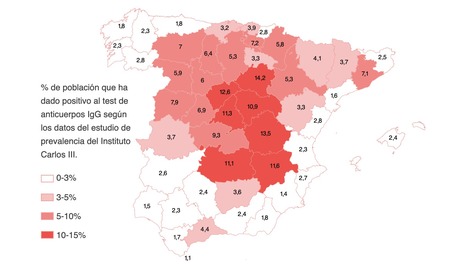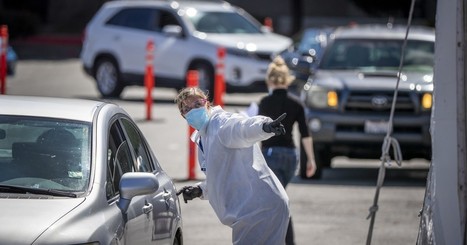 Your new post is loading...

|
Scooped by
Juan Lama
|
Published August 14, 2023 in CMAJ

|
Scooped by
Juan Lama
|
Spain is one of the European countries most affected by the COVID-19 pandemic. Serological surveys are a valuable tool to assess the extent of the epidemic, given the existence of asymptomatic cases and little access to diagnostic tests. This nationwide population-based study aims to estimate the seroprevalence of SARS-CoV-2 infection in Spain at national and regional level. 35,883 households were selected from municipal rolls using two-stage random sampling stratified by province and municipality size, with all residents invited to participate. From April 27 to May 11, 2020, 61 075 participants (75·1% of all contacted individuals within selected households) answered a questionnaire on history of symptoms compatible with COVID-19 and risk factors, received a point-of-care antibody test, and, if agreed, donated a blood sample for additional testing with a chemiluminescent microparticle immunoassay. Prevalences of IgG antibodies were adjusted using sampling weights and post-stratification to allow for differences in non-response rates based on age group, sex, and census-tract income. Using results for both tests, we calculated a seroprevalence range maximizing either specificity (positive for both tests) or sensitivity (positive for either test). Seroprevalence was 5·0% (95% CI 4·7–5·4) by the point-of-care test and 4·6% (4·3–5·0) by immunoassay, with a specificity–sensitivity range of 3·7% (3·3–4·0; both tests positive) to 6·2% (5·8–6·6; either test positive), with no differences by sex and lower seroprevalence in children younger than 10 years (<3·1% by the point-of-care test). There was substantial geographical variability, with higher prevalence around Madrid (>10%) and lower in coastal areas (<3%). Seroprevalence among 195 participants with positive PCR more than 14 days before the study visit ranged from 87·6% (81·1–92·1; both tests positive) to 91·8% (86·3–95·3; either test positive). In 7273 individuals with anosmia or at least three symptoms, seroprevalence ranged from 15·3% (13·8–16·8) to 19·3% (17·7–21·0). Around a third of seropositive participants were asymptomatic, ranging from 21·9% (19·1–24·9) to 35·8% (33·1–38·5). Only 19·5% (16·3–23·2) of symptomatic participants who were seropositive by both the point-of-care test and immunoassay reported a previous PCR test. The majority of the Spanish population is seronegative to SARS-CoV-2 infection, even in hotspot areas. Most PCR-confirmed cases have detectable antibodies, but a substantial proportion of people with symptoms compatible with COVID-19 did not have a PCR test and at least a third of infections determined by serology were asymptomatic. These results emphasize the need for maintaining public health measures to avoid a new epidemic wave. Published in The Lancet (July 6, 2020): https://doi.org/10.1016/S0140-6736(20)31483-5

|
Scooped by
Juan Lama
|
Health care workers (HCW) are a high-risk population to acquire SARS-CoV-2 infection from patients or other fellow HCW. At the same time, they can be contagious to highly vulnerable individuals seeking health care. This study aims at estimating the seroprevalence of antibodies against SARS-CoV-2 and associated factors in HCW from a large referral hospital in Barcelona, Spain, one of the countries hardest hit by COVID-19 in the world. From 28 March to 9 April 2020, we recruited a random sample of 578 HCW from the human resources database of Hospital Clínic in Barcelona. We collected a nasopharyngeal swab for direct SARS-CoV-2 detection through real time reverse-transcriptase polymerase chain reaction (rRT-PCR), as well as blood for plasma antibody quantification. IgM, IgG and IgA antibodies to the receptor-binding domain of the spike protein were measured by Luminex. The cumulative prevalence of infection (past or current) was defined by a positive SARS-CoV-2 rRT-PCR and/or antibody seropositivity. Of the 578 total participants, 39 (6.7%, 95% CI: 4.8-9.1) had been previously diagnosed with COVID-19 by rRT-PCR, 14 (2.4%, 95% CI: 1.4-4.3) had a positive rRT-PCR at recruitment, and 54 (9.3%, 95% CI: 7.2-12.0) were seropositive for IgM and/or IgG and/or IgA against SARSCoV-2. Of the 54 seropositive HCW, 21 (38.9%) had not been previously diagnosed with COVID-19, although 10 of them (47.6%) reported past COVID-19-compatible symptoms. The cumulative prevalence of SARS-CoV-2 infection was 11.2% (65/578, 95% CI: 8.9-14.1). Among those with evidence of past or current infection, 40.0% (26/65) had not been previously diagnosed with COVID-19, of which 46.2% (12/26) had history of COVID-19-compatible symptoms. The odds of being seropositive was higher in participants who reported any COVID19 symptom (OR: 8.84, 95% CI: 4.41-17.73). IgM levels positively correlated with age (rho=0.36, p-value=0.031) and were higher in participants with more than 10 days since onset of symptoms (p-value=0.022), and IgA levels were higher in symptomatic than asymptomatic subjects (p-value=0.041). The seroprevalence of antibodies against SARS-CoV-2 among HCW was lower than expected. Thus, being a high-risk population, we anticipate these estimates to be an upper limit to the seroprevalence of the general population. Forty per cent of those with past or present infection had not been previously diagnosed with COVID-19, which calls for active periodic rRT-PCR testing among all HCW to minimize potential risk of hospital-acquired SARS-CoV-2 infections. In summary, we found that 9.3% (95% CI: 7.2-12.0) of HCW from a large Spanish referral hospital (recruited from March 28th to April 9th, 2020) developed detectable IgA, IgG and/or IgM antibodies. Given that HCW are a high risk population for SARS-CoV-2, it is likely that the community seroprevalence is lower than this figure, showing that we are still very far from reaching the 67% herd immunity level that is estimated to be needed to protect the susceptible population,23 assuming that this immunity prevents from reinfection.

|
Scooped by
Juan Lama
|
Far more people may have been infected with Covid-19 than have been confirmed by health officials in Santa Clara County, California, according to a study released Friday in preprint. The study used an antibody blood test to estimate how many people had been infected with Covid-19 in the past. Other tests, like those performed with nasal swabs or saliva, test for the virus' genetic material, which does not persist long after recovery, as antibodies do. "We found that there are many, many unidentified cases of people having Covid infection that were never identified with it with a virus test," said Dr. Jay Bhattacharya, a professor of medicine at Stanford University and one of the paper's authors. "It's consistent with findings from around the world that this disease, this epidemic is further along than we thought." The study estimated that 2.49% to 4.16% of people in Santa Clara Country had been infected with Covid-19 by April 1. This represents between 48,000 and 81,000 people, which is 50 to 85 times what county officials recorded by that date: 956 confirmed cases.... If 50 times more people have had the infection, the death rate could drop by that same factor, putting it "somewhere between 'little worse than the flu' to 'twice as bad as the flu' in terms of case fatality rate," Bhattacharya said. Preprint of Original Study (April 17, 2020): https://www.medrxiv.org/content/10.1101/2020.04.14.20062463v1
|

|
Scooped by
Juan Lama
|
During the first wave of the COVID-19 pandemic, fewer than 10% of the US adult population formed antibodies against SARS-CoV-2, and fewer than 10% of those with antibodie swere diagnosed. Public health efforts to limit SARS-CoV-2 spread need to especially
target racial and ethnic minority and densely populated communities. Many patients receiving dialysis in the USA share the socioeconomic characteristics of underserved communities, and undergo routine monthly laboratory testing, facilitating a practical, unbiased, and repeatable assessment of severe acute respiratory syndrome coronavirus 2 (SARS-CoV-2) seroprevalence. For this cross-sectional study, in partnership with a central laboratory that receives samples from approximately 1300 dialysis facilities across the USA, we tested the remainder plasma of 28 503 randomly selected adult patients receiving dialysis in July, 2020, using a spike protein receptor binding domain total antibody chemiluminescence assay (100% sensitivity, 99·8% specificity). We extracted data on age, sex, race and ethnicity, and residence and facility ZIP codes from the anonymised electronic health records, linking patient-level residence data with cumulative and daily cases and deaths per 100 000 population and with nasal swab test positivity rates. We standardised prevalence estimates according to the overall US dialysis and adult population, and present estimates for four prespecified strata (age, sex, region, and race and ethnicity). The sampled population had similar age, sex, and race and ethnicity distribution to the US dialysis population, with a higher proportion of older people, men, and people living in majority Black and Hispanic neighbourhoods than in the US adult population. Seroprevalence of SARS-CoV-2 was 8·0% (95% CI 7·7–8·4) in the sample, 8·3% (8·0–8·6) when standardised to the US dialysis population, and 9·3% (8·8–9·9) when standardised to the US adult population. When standardised to the US dialysis population, seroprevalence ranged from 3·5% (3·1–3·9) in the west to 27·2% (25·9–28·5) in the northeast. Comparing seroprevalent and case counts per 100 000 population, we found that 9·2% (8·7–9·8) of seropositive patients were diagnosed. When compared with other measures of SARS-CoV-2 spread, seroprevalence correlated best with deaths per 100 000 population (Spearman's ρ=0·77). Residents of non-Hispanic Black and Hispanic neighbourhoods experienced higher odds of seropositivity (odds ratio 3·9 [95% CI 3·4–4·6] and 2·3 [1·9–2·6], respectively) compared with residents of predominantly non-Hispanic white neighbourhoods. Residents of neighbourhoods in the highest population density quintile experienced increased odds of seropositivity (10·3 [8·7–12·2]) compared with residents of the lowest density quintile. County mobility restrictions that reduced workplace visits by at least 5% in early March, 2020, were associated with lower odds of seropositivity in July, 2020 (0·4 [0·3–0·5]) when compared with a reduction of less than 5%. During the first wave of the COVID-19 pandemic, fewer than 10% of the US adult population formed antibodies against SARS-CoV-2, and fewer than 10% of those with antibodies were diagnosed. Public health efforts to limit SARS-CoV-2 spread need to especially target racial and ethnic minority and densely populated communities. Published in The Lancet (September 25, 2020):

|
Scooped by
Juan Lama
|
Only 5% of Spaniards have been infected with the coronavirus, according to preliminary data released of the seroprevalence study performed by the Instituto de Salud Carlos III, which tested near 70,000 participants. Infection rates show great geographic variation with some provinces having a prevalence seven times higher than others. Soria is the area with the highest percentage of people exposed to the disease, 14.2%. In Madrid the prevalence is 11.3%. Another conclusion from the preliminary report presented this afternoon is that more than 90% of the infections occurred in Spain were not detected by the health system. The country's official statistics reported 228,691 confirmed PCR-positive cases, but according to the preliminary data 2,350,000 people have been exposed to the disease, many without even noticing it. With 27,100 deaths reported in the country, the case fatality is estimated between 1 and 1.2% ", according to Jesús Molina Cabrillana, epidemiologist at the Spanish Society of Preventive Medicine, Public Health and Hygiene. Near one in three (33.7%) of the seropositive population had asymptomatic infections and passed the disease without noticing. Eight percent of the population with antibodies self-reported three or four symptoms, 14.7% more than five symptoms and 43% reported sudden loss of smell (anosmia). See also Study in the Lancet (July 6, 2020): https://doi.org/10.1016/S0140-6736(20)31483-5

|
Scooped by
Juan Lama
|
Hundreds of thousands of Los Angeles County residents may have been infected with the coronavirus by early April, far outpacing the number of officially confirmed cases, according to a report released Monday. The initial results from the first large-scale study tracking the spread of the coronavirus in the county found that 4.1% of adults have antibodies to the virus in their blood, an indication of past exposure. That translates to roughly 221,000 to 442,000 adults who have recovered from an infection, once margin of error is taken into account, according to the researchers conducting the study. The county had reported fewer than 8,000 cases at that time. The findings suggest the fatality rate may be much lower than previously thought. But although the virus may be more widespread, the infection rate still falls far short of herd immunity that, absent a vaccine, would be key to return to normal life. “We are very early in the epidemic, and many more people in L.A. County could potentially be impacted,” said Neeraj Sood, the study’s leader and a professor at USC’s Price School for Public Policy. “And as those number of infections arise, so will the number of deaths, the number of hospitalizations, and the number of ICU admissions.” The early results from L.A. County come three days after Stanford researchers reported that the coronavirus appears to have circulated much more widely in Santa Clara County than previously thought....
|



 Your new post is loading...
Your new post is loading...














